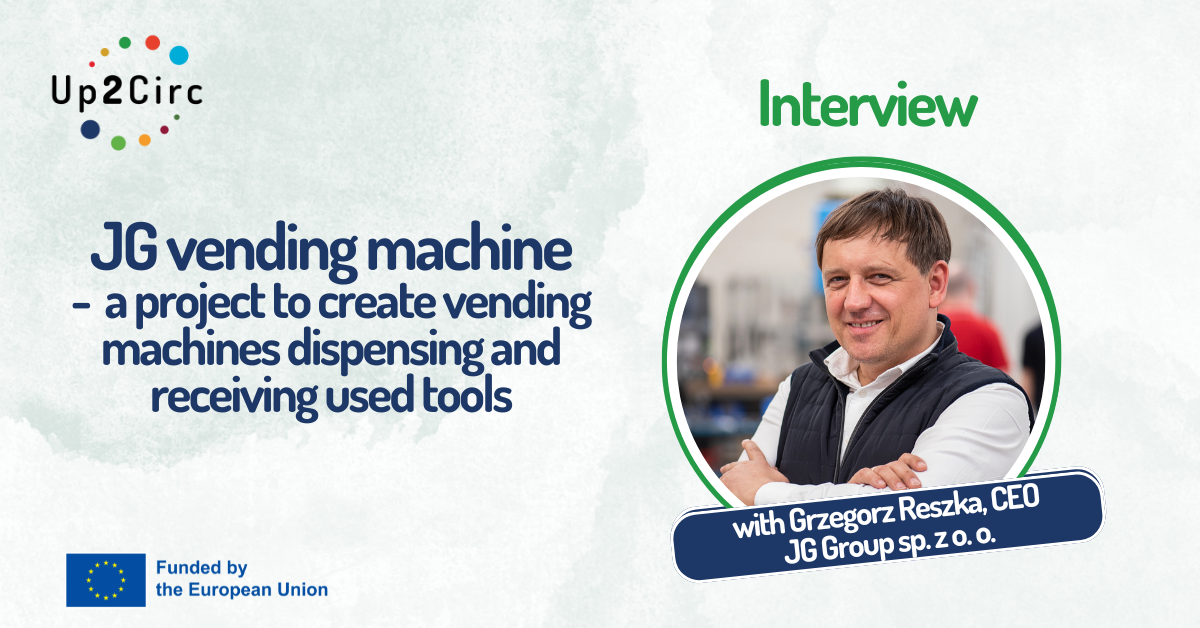
JG Group sp. z o.o.
Grzegorz Reszka, CEO
CNC Industry
Poland
JG Vending machine – a project to create vending machines dispensing and receiving used tools
PROJECT SCOPE
Introduction of new products, processes or services
CIRCULAR BUSINESS MODEL
Product as a service (Paas model)
Company and project background
Our company, JG Group, manufactures cutting tools and equipment for industry. We create various types of tools and components for the CNC machining and laser cutting industries, and we also have resources for material refinement and thermochemical treatment. As part of our additional activities, we provide cutting tool regeneration services, and we also design and create coolant filtration systems for CNC machines and vending machines, which are particularly useful for warehouse management in companies that have milling machines. By regenerating cutting tools, we have promoted recycling and the circular economy. This is a great way to save rare metals and plastic packaging. Coolant filtration systems also increase its durability and usability, which translates into lower coolant consumption in the company. The regeneration process is complemented by the introduction of vending machines for the return of used tools for regeneration and disposal. By monitoring wear and tear, as well as, to some extent, monitoring tool usage by employees, the machines translate into resource savings in manufacturing companies ranging from 15 to 25%, which significantly reduces waste in industry and the generation of unnecessary waste.
What motivated you to make your business more circular?
The impetus was the real need of our customers, namely manufacturing companies looking for ways to reduce waste and better manage used tools. Market changes and growing environmental awareness in the industry were additional motivators. Both internal factors and external expectations played a role here.
Implementation Process
What were the objectives of your project?
Our main goal was to reduce waste and enable customers to reuse tools through regeneration, thus supporting our service business. We also wanted to increase the efficiency of tool logistics, which we believe is extremely important today and allows companies to generate huge savings without reducing jobs or human resources.
What activities did you carry out as part of your project?
We developed industrial vending machines from scratch, equipped with slots for tool regeneration and disposal. The entire design and development team as well as external technology partners were involved. The prototype was thoroughly tested at our company due to the similar profile of our business to that of our customers, which allowed us to refine its functionality before full commercialization.
What feedback did you receive from stakeholders (customers, suppliers etc.)?
The feedback was very positive. Customers appreciated the simplicity of the solution and the real savings. There were also suggestions regarding the optimization of the capacity of the drop box and messages in the system, which we implemented. Cooperation with customers in gathering feedback was crucial.
Impact & Outcomes
What are the main results and outcomes of the project for your company?
We supported the regeneration service, which opened up an additional revenue stream. Customers began to use our machines more often as a tool for managing the entire tool life cycle, not just dispensing. In terms of image, our company is perceived as more innovative and responsible.
Did you detect a positive impact of circular transition for your company and for the environment?
Definitely yes. Tool regeneration reduces material consumption, and the tool performs just as well in rough machining. This has a real environmental impact. We monitor the number of tools recovered and their reuse.
Which changes have you already implemented?
The vending machines with slots are already in use by customers. The collection, pickup, and recycling process operates as a regular service. The changes are fully integrated into our daily operations and logistics.
Lessons learned
What key lessons did you learn regarding circular innovation?
The most important lesson is that it is worth starting with simple, real customer problems. Second, involving end users in testing and providing feedback is the key to success. We were also surprised by how quickly customers accepted and implemented the new model.
Did you encounter any challenges?
The technical challenges mainly concerned the design of the machines and their reliability in industrial conditions. Additional difficulties included the logistics of collecting used tools in cases where we did not have a sales team on site. Financial support from Up2Circ was crucial in minimizing risk.
If you could do your project again, what would you do differently?
We would have involved customers in the design process earlier. Their early comments would have saved time on later corrections.
Future plans & recommendations
What are your next steps towards circular transition? (Which partners would you like to team up with/collaborate)?
We plan to develop the regeneration service on a larger scale, including for other types of tools. We are also considering cooperation with tool manufacturers in a partnership model. We also want to expand the functionality of the machine with tool wear analytics.
Is there any advice you would give to other SMEs looking to implement a circular project?
Start with a problem that really affects your customers. That’s the best place to start. Don’t try to implement everything at once. Small, specific steps bring the greatest results. And remember, don’t be afraid of testing and prototyping.
How can policymakers or financial institutions better support businesses in adopting circular practices?
Support such as that provided by Up2Circ is extremely helpful during the development and testing phase. However, there is a lack of programs supporting the implementation of already functioning solutions on a large scale. More industry training and tax incentives for companies using regeneration and recycling services would be useful.
